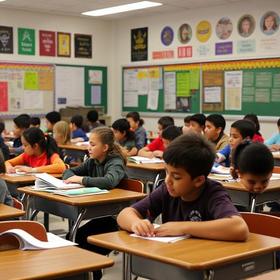Top Rankings
North Carolina Cyber Academy School District ranks among the top 20% of public school district in North Carolina for:
Category
Attribute
Diversity
Most diverse schools (Top 1%)
For the 2025-26 school year, there is 1 public school serving 2,523 students in North Carolina Cyber Academy School District. This district's average testing ranking is 3/10, which is in the bottom 50% of public schools in North Carolina.
Public School in North Carolina Cyber Academy School District have an average math proficiency score of 28% (versus the North Carolina public school average of 51%), and reading proficiency score of 50% (versus the 50% statewide average).
Minority enrollment is 56% of the student body (majority Black), which is less than the North Carolina public school average of 57% (majority Black and Hispanic).
Overview
This School District
This State (NC)
# Schools
1 School
2,761 Schools
# Students
2,523 Students
1,546,447 Students
# Teachers
141 Teachers
100,041 Teachers
Student-Teacher Ratio
18:1
18:1
Student By Grade
District Rank
North Carolina Cyber Academy School District, which is ranked within the bottom 50% of all 320 school districts in North Carolina (based off of combined math and reading proficiency testing data) for the 2021-2022 school year.
The school district's graduation rate of 56% has increased from 20% over five school years.
Overall District Rank
#233 out of 325 school districts
(Bottom 50%)
(Bottom 50%)
Math Test Scores (% Proficient)
(21-22)28%
51%
Reading/Language Arts Test Scores (% Proficient)
50%
50%
Science Test Scores (% Proficient)
53%
63%
Graduation Rate
(21-22)52%
86%
Students by Ethnicity:
Diversity Score
0.70
0.71
% American Indian
1%
1%
% Asian
3%
4%
% Hispanic
16%
21%
% Black
29%
25%
% White
44%
43%
% Hawaiian
n/a
n/a
% Two or more races
7%
6%
All Ethnic Groups
District Revenue and Spending
The revenue/student of $7,298 in this school district is less than the state median of $11,191. The school district revenue/student has declined by 5% over four school years.
The school district's spending/student of $6,936 is less than the state median of $11,616. The school district spending/student has declined by 5% over four school years.
Total Revenue
$18 MM
$17,307 MM
Spending
$18 MM
$17,964 MM
Revenue / Student
$7,298
$11,191
Spending / Student
$6,936
$11,616
Best North Carolina Cyber Academy School District Public Schools (2025-26)
School
(Math and Reading Proficiency)
(Math and Reading Proficiency)
Location
Quick Facts
Rank: #11.
North Carolina Cyber Academy
Charter School
(Math: 28% | Reading: 50%)
Rank:
Rank:
4/
Bottom 50%10
2800 Meridian Parkway, Suite 1
Durham, NC 27713
(984) 262-9237
Durham, NC 27713
(984) 262-9237
Gr: K-12 | 2,523 students Student-teacher ratio: 18:1 Minority enrollment: 56%
Frequently Asked Questions
How many schools belong to North Carolina Cyber Academy School District?
North Carolina Cyber Academy School District manages 1 public schools serving 2,523 students.
What is the rank of North Carolina Cyber Academy School District?
North Carolina Cyber Academy School District is ranked #233 out of 320 school districts in North Carolina (bottom 50%) based off of combined math and reading proficiency testing data for the 2021-2022 school year. This district ranks in the top 20% of North Carolina school districts for: Most diverse schools (Top 1%)
What is the racial composition of students in North Carolina Cyber Academy School District?
44% of North Carolina Cyber Academy School District students are White, 29% of students are Black, 16% of students are Hispanic, 7% of students are Two or more races, 3% of students are Asian, and 1% of students are American Indian.
What is the student/teacher ratio of North Carolina Cyber Academy School District?
North Carolina Cyber Academy School District has a student/teacher ratio of 18:1, which is higher than the North Carolina state average of 15:1.
What is North Carolina Cyber Academy School District's spending/student ratio?
The school district's spending/student of $6,936 is less than the state median of $11,616. The school district spending/student has declined by 5% over four school years.
Recent Articles

How Public Schools Support Students on Free / Reduced-Lunch Programs
Explore how U.S. public schools support students eligible for free or reduced-price lunch through nutrition, academic, and wraparound services in 2025.

Hidden Costs of Public Schools: Fees, Supplies & Extras
Explore the hidden costs in public schools—fees, supplies, extracurriculars—and how parents can plan for them in 2025.

Public School Funding 2025: What Families Should Know
Essential insights on public school funding in 2025—how it works, what’s changing, and what families should know to stay ahead.





